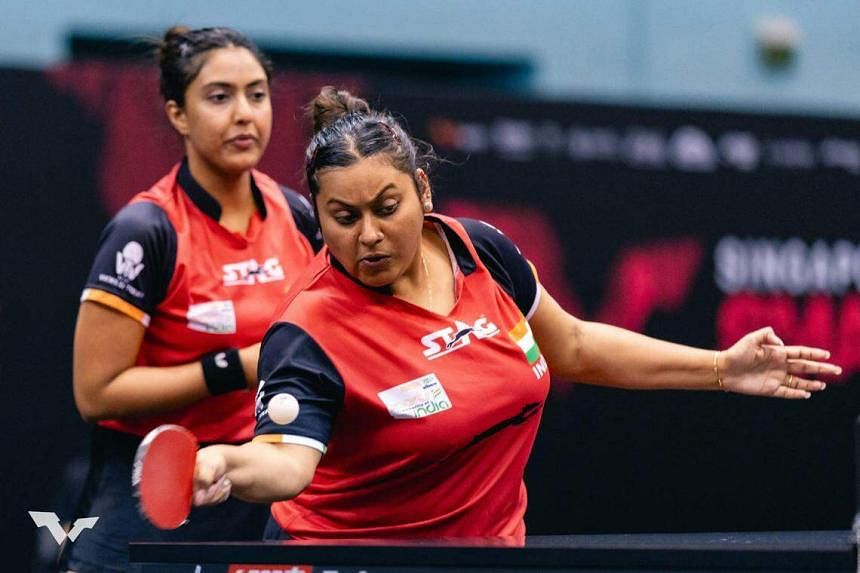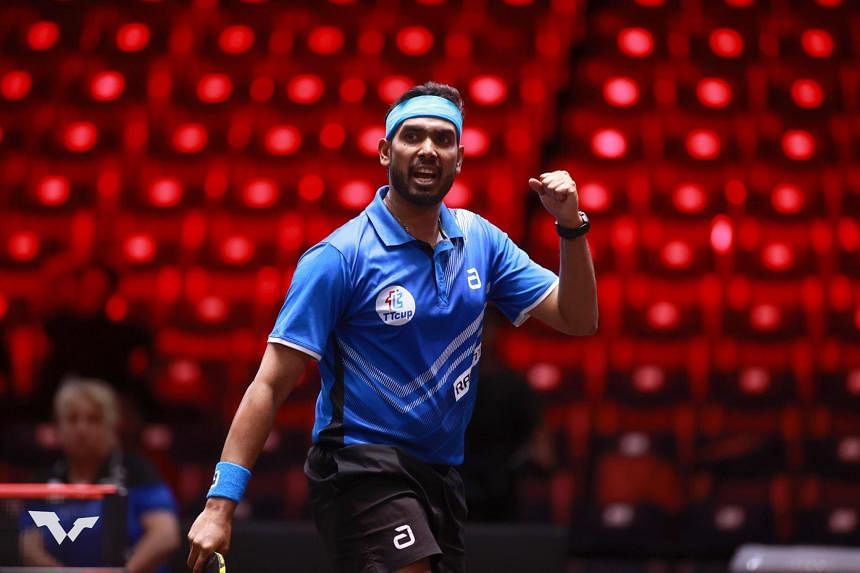SINGAPORE – After watching their women’s team lose 3-2 to China at the World Team Table Tennis Championships in February, Table Tennis Federation of India (TTFI) secretary-general Kamlesh Mehta called it “the greatest day for Indian table tennis”.
The seemingly hyperbolic statement was understandable, as they had won two singles matches against the mighty Chinese. Ayhika Mukherjee, then ranked 155th, stunned world No. 1 Sun Yingsha 3-1 and Sreeja Akula, ranked 49th, swept aside then world No. 2 Wang Yidi 3-0.
When the team ranking for March was published, India’s men’s team were placed 15th, while the women were 13th. This meant both secured Olympic qualification for the first time since the sport introduced team events at Beijing 2008.
At the ongoing Singapore Smash, Akula pushed current world No. 3 Wang Manyu in the first round of the women’s singles before losing 3-2, while world No. 88 Sharath Kamal was ousted in the men’s quarter-finals after coming through the qualifiers and beating three higher-ranked opponents in the main draw.
Kamal, a 10-time national champion, attributed his country’s rise to the TTFI’s ability to develop and retain talent, as well as the launch of the Ultimate Table Tennis (UTT) league in 2017.
The 41-year-old added: “When I started my career (at age 16), it was predominantly the coach who used to take care of physical and mental fitness, video analysis and everything else. But now, we have different departments and people for these jobs to help the player perform.
“Also, prior to 2017, there used to be one player here and there, but now we can see a bunch of juniors doing extremely well, Payas Jain (Under-17) and Manav Thakkar (Under-21) reaching world No. 1 in the junior rankings. The Indian league has also contributed a lot to our experience and confidence that we are having.”
Each owner of the six UTT franchises paid 26 million rupees (S$419,500) in a 10-year deal, with player salaries ranging from 150,000 to two million rupees, depending on their ranking and stature. The winning team receive a third of the 30 million rupees purse.
In 2023, the UTT attracted the likes of top Africans like Nigeria’s Quadri Aruna and Egypt’s Omar Assar.
India’s top-ranked women’s singles player Manika Batra (world No. 36) said: “Usually, no one watches table tennis. But everyone is watching us now, it’s a big thing for the sport to be on TV.”
Perhaps, such exposure has helped to change mindsets. When they were growing up in Naihati in West Bengal, Sutirtha Mukherjee and Ayhika Mukherjee (not related) were told not to wear shorts and stick to singing or dancing.
But with the support of forward-thinking parents, they picked sport when they were around six and in 2023, they stunned world No. 3 Chen Meng and Wang 3-1 en route to an Asian Games women’s doubles bronze.
Similarly, Akula was allowed to juggle sport and studies – she scored 9.5 out of 10 for her cumulative grade point average in 10th grade and was in the 96th percentile in 12th grade – before her world championships exploits.
Akula, 25, said: “My relatives questioned why my parents put me in sport, but I always wanted to do something good for my country. I was inspired to win medals when I watched big brother Sharath’s matches.”
Ayhika, 26, said corporate support has also helped. She works in a bank, while Sutirtha is employed by a railway company but instead of going to work, they train full time for five to six hours a day.

Another key to their success has been their unorthodox style of play.
Akula uses her long-pimpled backhand as a blocker but is also adept at attacking with her forehand topspins.
For the Mukherjees, who train together at the Dhanuka Dhunseri Soumyadeep Poulomi Academy in Kolkata, Sutirtha uses short pimples on her forehand and a flat rubber which helps her change the speed or spin for her returns, while Ayhika has been confounding opponents with her anti-spin backhand.
Sutirtha, 28, said: “Opponents don’t understand how we play because we have totally different games. She uses her anti-spin very well to slow down the game, so I have a very good advantage to kill off the point.”
While Kamal admitted table tennis will never reach the heights of cricket in his country – “cricket is more than sport” – he felt it can become as popular as badminton and tennis, sports which have had Indian world champions and Grand Slam winners.
In 2023, Mehta announced a new centre of excellence and academy in Bengaluru and Odisha, and plans to host international tournaments for seniors and youth while noting that former players are taking up full-time private coaching.
Kamal said: “Table tennis has come a long way in India. We are not the best in the world but now is the time to get better.”


